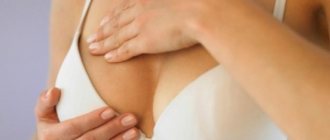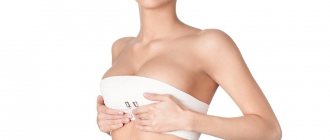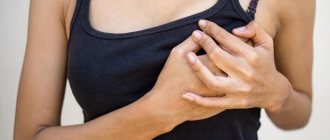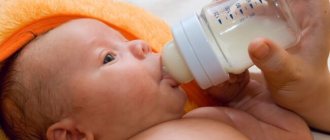Causes and associated symptoms
Redness of the breast can be caused by various factors. One of the most common ones is the first weeks of feeding. As a rule, problems begin with the appearance of cracks in the nipples. The breasts become red during breastfeeding if a woman suffers from various diseases.
As soon as the baby begins to feed on mother's milk, women complain of cracked nipples. They do not appear immediately. At first, my breasts hurt during feeding. After some time, red spots appear. After 3-4 days, the red areas bleed.
Women call this problem the most pressing, since almost all mothers face it. The main symptom of the disease is breast hardness. If the mammary glands do not empty enough, this leads to blockage of the ducts.
In addition to pain, the woman develops a fever, her breasts become hard, and a certain area feels tight.
Lactostasis occurs due to the use of incorrect feeding techniques and premature weaning of the baby. Women experience lactostasis if they feed their children against their wishes.
The presence of lactostasis in a woman leads to the development of mastitis. Milk that is not promptly removed from the mammary glands leads to tissue swelling. In turn, they begin to become inflamed. The woman’s condition worsens, her breasts cannot be touched, and her body temperature rises.
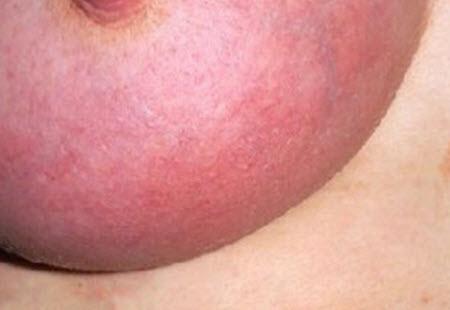
If a woman is diagnosed with mastitis and appropriate treatment is not prescribed, an abscess develops as a result of the disease. At the site of engorgement, the resulting cavity is filled with pus. It penetrates into milk, so feeding the child at the time of illness is suspended. An abscess often develops in only one breast.
After the examination, the doctor may allow the baby to be fed from a healthy mammary gland. In case of an abscess, self-medication is prohibited.
The appearance of lumps in the mammary glands is not the only problem women face. During breastfeeding, organs stop functioning. When the baby is born, the mother's breast does not produce milk. As a result, lactation is impossible.
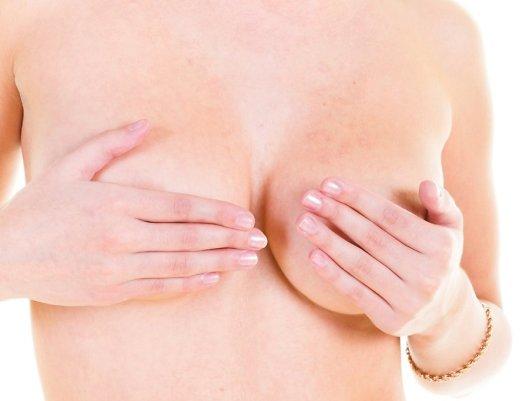
There are no characteristic symptoms of hypogalactia. The breasts look normal, there is no redness. The mammary glands do not enlarge, but the child’s behavior changes. With hypogalactia, milk can be produced. But after 3-4 weeks the amount gradually decreases. There are no disturbances in the functioning of other organs.
Therapy
Treatment of urticaria in women during breastfeeding has a number of features.
Most medications can pass into breast milk and affect the baby. That is why mother should be careful when choosing medications and strictly adhere to the doctor’s recommendations.
With the exception of particularly severe cases, treatment of urticaria is carried out at home, but under the supervision of a specialist.
Prescribed therapeutic measures have several main goals:
- identify and eliminate the factor that provokes the disease;
- cleanse the body (blood and breast milk) of allergens and other toxic substances;
- relieve itching and discomfort;
- cure skin rashes and prevent possible relapses.
Since the disease occurs quite often, including in women after childbirth, medicine has a large arsenal of proven and safe treatment methods for this case.
Itching Remedies
The choice of drugs to combat itchy rashes should be done with great care. During this period, hormonal ointments are strictly contraindicated for a woman . The active ingredients of such drugs penetrate into the milk and pose a threat to the baby. The safest remedies for relieving itching during breastfeeding are:
- Bepanten ointment;
- aqueous solution of table vinegar (1:1);
- cucumber juice;
- aloe juice;
- decoctions of some herbs (chamomile, string, elderberry), if there is no allergy to these plants;
- if the rashes occupy a significant area, you can take a warm bath with oatmeal or vinegar dissolved in it;
- The use of moisturizing creams with vitamins (Lipobase) will not cause harm.
If it is possible to identify and eliminate the allergen, the external signs of the disease should disappear on their own in a short time.
Determining the reason
Only a specialist can make an accurate diagnosis. Listing all the symptoms that the patient has will help the doctor determine the cause. If a woman begins treatment on her own, this can lead to negative consequences. It is prohibited to take antibiotics without medical supervision.
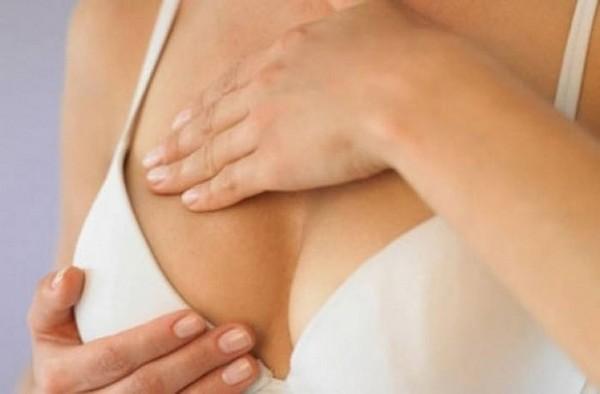
As a rule, at the first symptoms of disease, people consult a gynecologist. If necessary, the doctor refers the patient to an appointment with a mammologist. In some cases, a surgeon may be needed. In cities, antenatal clinics have breastfeeding specialists.
First of all, the specialist examines the patient’s mammary glands. Palpation allows you to determine the degree of breast engorgement. To obtain more detailed information, the patient is referred for an ultrasound of the mammary glands.
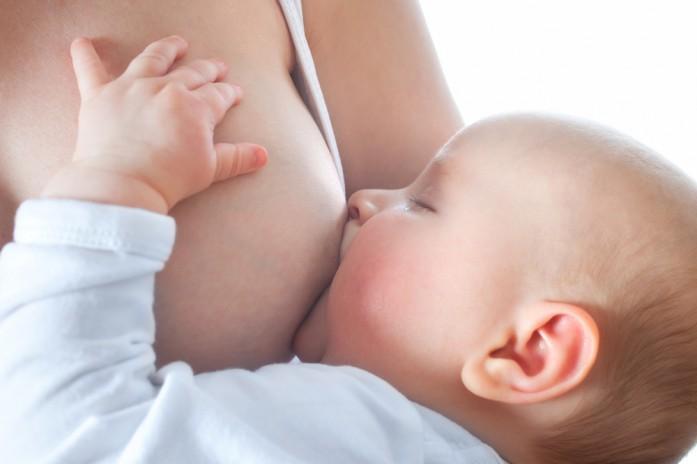
Prescribing appropriate treatment
If a woman experiences lactostasis or mastitis, doctors prescribe a standard treatment regimen. It includes:
- massage of the mammary glands;
- expressing milk;
- applying warm compresses to the chest.
Treatment of non-infectious mastitis takes no more than 3-4 days. It only takes a day to get rid of lactostasis.
As a rule, antibiotics are not used for lactostasis. The need for the use of antibacterial agents arises as a result of the transition of the disease to infectious mastitis. If a woman has non-infectious mastitis and there are cracks in her nipples, medications are also prescribed. Infection can enter the body through open wounds.
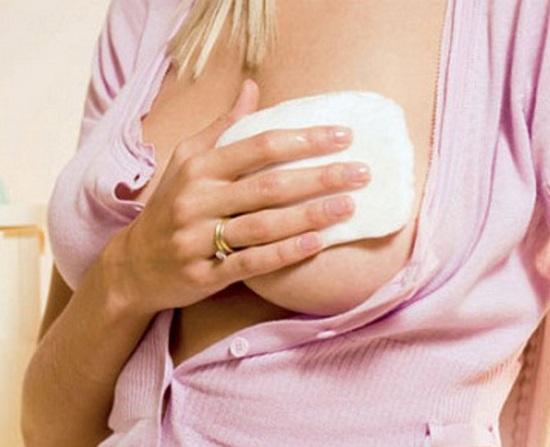
Treatment of an abscess takes much longer. Therapy for this disease is selected for each patient individually. Treatment is necessarily comprehensive. In severe cases, surgery may be necessary.
Diseases associated with the mammary glands can be easily treated with physiotherapy. They help if there is no positive result from pumping and massage. Ultrasound is most often used in medicine. It is the most effective and safe, does not cause pain.
With a disease such as lactostasis, a woman is allowed to breastfeed her child. Some doctors prescribe antibacterial drugs, and mothers are upset that they will not be able to put their babies to the breast. The pharmaceutical market is ready to offer a lot of drugs that are approved for hepatitis B.

Antibiotics are prescribed exclusively by the attending physician. The specialist will select the right dosage depending on the patient’s condition. Antibacterial therapy lasts from 5 to 10 days.
How to prevent illnesses from occurring
You can avoid the development of various diseases if you follow a number of important and simple rules. Everything depends on the correctness of the woman’s actions. If you constantly care for your breasts, a nursing mother will not encounter lactostasis, mastitis, abscess and other diseases. Rules for caring for the mammary glands:
- Take a shower at least 1-2 times a day. Carry out water procedures in the morning and evening. Wash your breasts thoroughly.
- Use soap when washing no more than once a day.
- Before feeding your baby, do not treat nipples with products that dry out the skin. This property is possessed by brilliant green, alcohol and other substances.
- Wet breasts are easily dried with a towel. Rubbing is prohibited, as the procedure can not only irritate the skin, but also injure the nipples.
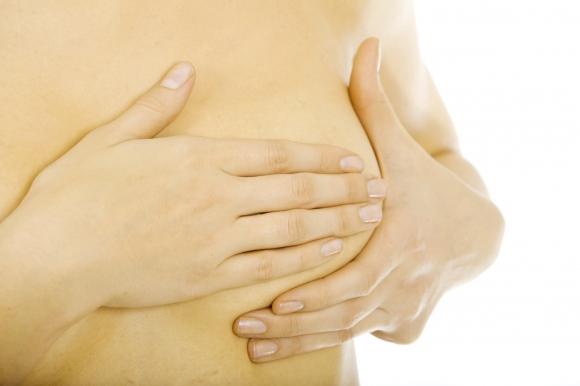
Experienced mothers advise lubricating the nipples with drops of hind milk at the end of feeding. This is the best remedy for dryness. It not only protects the nipple, but also has healing properties.
Women make the mistake of immediately covering their breasts after feeding. It is more beneficial to leave the chest open for 10-15 minutes. This way, the nipples will dry naturally and the likelihood of developing diseases will be reduced.
Milk is released from the nipples from time to time throughout the day. This negatively affects delicate skin, as it is constantly wet. This environment is suitable for the development of microbes.
Frequent bathing will not solve the problem. And not every woman has the time and opportunity to carry out water procedures. Special pads absorb breast milk that is released between feedings. Every breastfeeding woman should try this convenient item.
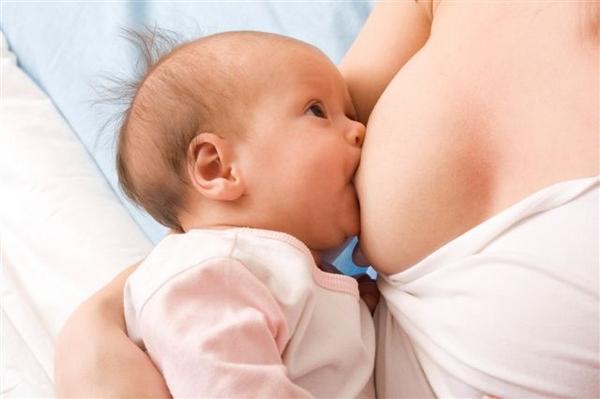
During breastfeeding, a woman encounters many new sensations. And also with a variety of symptoms that may be part of the pathological clinical picture. Redness of the breasts during feeding is one of the important signs that you should listen to and, if necessary, undergo additional diagnostics from a doctor.
What to do if your breasts itch while breastfeeding
Doctors unanimously recommend not scratching the delicate skin on the chest and mammary glands. Through microcracks formed as a result of scratching, infection can enter and only aggravate the situation with additional diseases.
If you suspect that itching in the chest is caused by dry skin, underwear or allergies, you should:
- Avoid tanning on the beach and in the solarium.
- Saturate the diet with the necessary amount of liquid, preferably clean drinking water. (It is believed that it is advisable for a person to consume an average of 1.5 liters of clean water per day).
- Humidify the air in the room (buy a humidifier or place large containers of water).
- Avoid hot baths, and when washing, try to use a soft natural sponge and hypoallergenic detergents.
- Replace washing powder, lotion, cream and other detergents and care products that come into contact with the skin of the body with neutral ones, without fragrances and perfume additives.
- Change your underwear to a higher quality one, with the maximum composition of natural fibers, and, of course, choose it according to your size.
If skin itching does not go away a few days after taking the above measures or is accompanied by any other symptoms (redness, rash, pain, discharge from the nipples, fever), you should definitely visit a doctor.
This is also worth doing if you suspect that recently prescribed medications have caused allergies and itching.
Regardless of whether your right breast itches, your left breast, or both at once, you should not hesitate, self-medicate, and especially guess by signs. This can be dangerous to health, and sometimes even to life, since lost time can lead to aggravation of the disease and serious complications.
Many women and girls face the problem of itchy breasts during breastfeeding (breastfeeding). This is most often due to the fact that milk comes in, the breasts increase in size, the skin stretches and begins to itch.
During milk production, during lactation, the milk ducts are filled with a large amount of milk, blood circulation increases significantly. This leads to changes in the size of the mammary glands and stretching of the skin.
This phenomenon is not considered a problem, but rather a common occurrence during breastfeeding, although it brings considerable discomfort, because the constant feeling of dryness, itching and flaking is exhausting and does not allow you to fully rest and take care of the child.
Typically, the breasts stop itching after the lactation process improves, milk is produced exactly as much as the baby needs, and the mammary glands take on a certain size.
If a nursing mother has been bothered by itching in the breast area for a long time, first of all, she should not scratch it in order to avoid infection through cracks in the skin.
And of course, you need to understand the possible reasons why the mammary glands may still itch.
Indeed, in some cases, when even with established lactation, the feeling of discomfort does not go away, itching may be a sign of other concomitant diseases. Here are the most common of them:
- nipple thrush;
- avitaminosis;
- mastitis;
- improper attachment during feeding.
Many mothers who are too busy caring for the baby may ignore painful and uncomfortable sensations. But if your breasts continue to itch, it is better to consult a doctor for examination and to identify possible causes.
It is necessary to consider in more detail all the possible signs of the above diseases that can provoke a constant desire to scratch the chest, as well as ways to combat them.
Thrush
The largest number of women begin to suffer from nipple candidiasis in the first weeks after starting to feed the baby.
This is explained by the fact that feeding has not yet been established, the regularity of hygiene procedures has not been established, or during pregnancy the woman’s immunity has greatly decreased.
This means that it is easier for the fungus to multiply in the skin of the breast and nipples, which have not yet become stronger, have not become rough and could have been injured during the feeding process. What other reasons can cause the development of thrush:
- chronic disease candidiasis, which occurs in the body and recurs with manifestation in the nipple area;
- taking hormonal contraceptives;
- excessive consumption of sweet, starchy, salty foods;
- deep cracks in the nipples;
- diabetes.
An untreated infection can be transmitted to the baby during feeding, so you need to know what symptoms are accompanied by candidiasis. The main features include:
- unpleasant itching sensation around the nipples;
- redness and peeling of the skin;
- small scales and whitish blisters on the nipples;
- slight swelling.
If there is no pain, the presence of a disease in the mother may be signaled by the child’s restless behavior. After all, he also has manifestations of thrush in his mouth, which prevent him from fully sucking milk, the mucous membrane is itchy, the child often cries and refuses to eat due to pain.
It is necessary to treat candidiasis, but drugs that are suitable for this purpose must be prescribed by a doctor. Self-medication is not recommended at all, and doubly so during pregnancy and lactation.
After all, it is unknown what kind of reaction this or that medication can give to the body of the mother and child. If ointments and gels that are applied externally can clog the milk ducts, then uncontrolled use of tablets inside can become downright dangerous.
It is necessary to treat mother and child at the same time, because an untreated child will again introduce the infection into the mother’s body.
If the fungus has severely affected the body, and the soda solution does not have the desired effect, the doctor may recommend applying Nystatin ointment to the skin.
It is applied to the skin immediately after feeding and washing the nipples, and also 30 minutes before putting the baby to the breast. The mammary glands need sunbathing for 15–20 minutes, and also monitor hygiene.
Wash your breasts regularly and sterilize everything that comes into contact with them - underwear, breast pump, breast pads.
In addition to external treatment, you need to start taking medications containing bifidobacteria and lactobacilli: they will help restore the correct microflora in the body. It is worth paying attention to your diet and the foods you eat. The exceptions for thrush should be soda, yeast products, sweets and fruits. You need to drink more green tea and fermented milk drinks.
You cannot stop the course of treatment immediately after the main signs of candidiasis have disappeared, because getting rid of this fungus is not so easy. If the disease is detected in a timely manner and treatment is started immediately, then the chances of getting rid of it will be many times higher than with an advanced stage of thrush.
You should also try not to stop breastfeeding during the course of treatment. After all, you can overcome candidiasis quite quickly with some effort.
At the same time, the child will continue to receive all the beneficial substances and vitamins contained in breast milk, which will support his immunity and overall health.
Mastitis
If a nursing mother's breasts itch, this may be a signal of developing mastitis. When the glands are not completely emptied of milk and the pumping process is ignored, the process of inflammation begins.
The first symptom is severe itching, and if this sign is not paid attention to in time, the inflammation will worsen, turning into a purulent form.
Itching occurs due to the appearance of cracks and microtraumas of the skin on the nipples, and through these cracks the infection penetrates deep into the gland.
The main symptoms of mastitis are:
- a sharp increase in body temperature, sometimes up to 38.5–39 degrees;
- feeling of a “burning” chest;
- soreness, itching.
In this case, contacting a doctor is mandatory; as a pre-medical measure, you can use an ice compress wrapped in thick cloth.
If the temperature is low and the woman’s general condition is satisfactory, conservative treatment is prescribed.
Antibiotics are used that are compatible with continued breastfeeding, but if there are indications for this, breastfeeding should be stopped for a while. It is possible to prescribe physiotherapy (usually at the recovery stage).
If mastitis has entered the stage of a purulent inflammatory process, surgical intervention is indicated.
The best prevention of this disease is to completely empty the breast after feeding.
After the breast has been emptied, it may be helpful to apply ice to the breast for 5 to 10 minutes to relieve swelling and heat.
You need to put your baby to the breast as often as possible: he became infected with the infection even before the first manifestations of the disease, and with mother’s milk the baby will receive not only harmful microbes, but also immunity against them.
Avitaminosis
The diet of a nursing mother should contain a complete set of vitamins, micro- and macroelements, fats and saturated acids. If your mammary glands itch during breastfeeding, this may be a sign that your body lacks vitamins.
First of all, you need to establish a diet that provides the woman with all the necessary substances that are important for the health of both the mother and the child. Flaky skin and itching are signs of a lack of vitamins A, E and C, as well as Zinc.
You can include foods containing sufficient amounts of these vitamins in your menu or start taking special vitamin complexes that your doctor will prescribe.
Many have forgotten about the benefits of fish oil, but it contains Omega 3 acids, which will maintain a healthy nervous system, improve blood circulation and absorption of nutrients, in particular vitamin D. While taking fish oil, to get rid of the feeling of itching in the chest area, you need to take sunbathing and spend more time in the air.
The consequences of improper breastfeeding technique include damage to the nipples, cracks and microtraumas of the skin, which can also cause constant scratching of the mammary glands. Itching and a feeling of discomfort appear when the baby rubs the skin of the nipple, trying to pull it in and pushing it back out during improper attachment.
Causes and symptoms of skin redness
During the breastfeeding period, women may encounter physiological and pathological causes of redness of the mammary glands. In the first case, the condition improves without visiting a doctor or taking various medications; in the second, consultation and prescription of suitable therapy are required. But it can be difficult to independently distinguish pathology from the body’s natural reaction.
Some women discover redness on their breasts even before breastfeeding, immediately after childbirth. This is considered one of the indicators of the norm - the body is preparing for the upcoming process so that there is enough milk.
The breast tissue is stretched, causing pain and severe redness. But all this goes away a few days after the young mother begins to put the baby to the breast.
The pain may also be associated with excessive milk production, then additional symptoms appear: leakage of secretion from the glands, severe swelling and redness. These signs may persist for several months until the feeding regimen is completely normalized and the breasts become accustomed to such processes.
The problem may also be due to improper attachment of the baby. If during sucking the baby does not fully grasp the nipple so that it is pressed against the roof of the mouth, this causes discomfort and even pain. The problem is sometimes due to the fact that the child has an incorrect structure of the frenulum of the tongue - it is too short. Then the feeding technique cannot be performed correctly.
There is another reason for redness - increased sensitivity of the areola. This area contains many nerve endings, so the following symptoms may occur after feeding:
- burning;
- pulling sensations;
- soreness;
- tingling;
- swelling and puffiness;
- severe redness in the nipple area.
During the adaptation process, these symptoms weaken and gradually disappear. A woman can help herself by constantly massaging the glands until the first drops of milk.
The general sensitivity of the body can also become a problem with redness of the glands. This includes not only physical influences. Stress, emotional sensitivity, and excessive activity negatively affect some women during the breastfeeding period.
You need to follow certain rules to avoid deterioration of well-being and redness of the chest:
- rest well and try to get enough sleep;
- find suitable relaxation techniques, be it meditation or watching your favorite TV series at least 1 hour a day;
- do not engage in active sports;
- shower regularly.
If acute symptoms occur during feeding - severe pain, fever, nausea - you should consult a doctor for diagnosis. After all, the cause of unpleasant sensations may be hidden in conditions provoked by stagnation of milk.
Lactostasis is a disease in which milk stagnates in the breast. This may be caused by the following reasons:
- blockage of the mammary duct;
- incorrect feeding technique;
- insufficient milk sucking by the child.
The pathology is accompanied by redness, severe burning and pain. Dense formations may develop in the lobules of the glands. For an accurate diagnosis, you need to see a doctor. To prevent lactostasis, it is important to examine your breasts every day during feeding.
When the first symptoms of lactostasis appear, to prevent the worsening of the situation and the development of mastitis, it is recommended to take Lactanza, a natural remedy in the form of capsules containing the probiotic Lc40, which is a normal inhabitant of the microflora of a woman’s mammary glands. Lc40 Lactans reduce breast pain and regulate the level of pathogenic bacteria in milk, which reduces the risk of mastitis by 2 times. Lactanza helps maintain healthy breastfeeding and is beneficial for both mother and baby - the Lc40 probiotic reduces the incidence of intestinal infections in the newborn by 70%.
Sometimes pathology is detected even before symptoms appear: when palpating, pain is felt, areas of the skin begin to change color, and small lumps are found under the skin. However, with lactostasis the temperature does not rise, and signs of malaise do not bother the woman. Mastitis can be a complication of this pathology.
If the pain is concentrated in the nipple area, as well as redness, this indicates the appearance of cracks. Outwardly they may not be noticeable. The following reasons can provoke a violation:
- lack of essential vitamins – A, E, D, C, B;
- improper or insufficient hygiene;
- incorrect feeding technique.
Incorrect cosmetics used for gland hygiene can provoke pathology. The products used to disinfect nipples before feeding should not contain alcohol.
You can reduce the risk of developing cracks by lubricating the nipple with the first drop of milk during feeding. Sometimes the cause of the condition can be too delicate skin of the nipple area, which is not affected by any prevention methods. In this case, the woman will have to endure time during which the nipples will harden.
Very often mastitis develops as a result of other disorders - cracks, stagnation of milk. It provokes the rapid proliferation of pathogenic flora inside the mammary glands. The pathology is characterized by pronounced symptoms:
- severe redness and pain in the mammary glands in a nursing mother;
- deterioration in general health;
- high temperature – 38-38.5 degrees;
- changes in breast structure, formation of tubercles;
- constant persistence of painful sensations.
Mastitis requires serious treatment under the constant supervision of a specialist. This is the only way to avoid more serious consequences that will have to be dealt with surgically.
If during lactation the mammary gland turns red and additional symptoms appear, this may be a consequence of the following pathologies:
- Breast abscess. Develops against the background of mastitis in the absence of treatment. An abscess filled with pus appears in the area of hardening. During the period of an abscess, you cannot feed the child.
- Hypogalactia. Characterized by little or no milk production. The baby's attempt to suckle irritates the gland, causing it to turn red.
To avoid all these violations, it is necessary to monitor feeding techniques, hygiene, nutrition, and the linen used. The development of dangerous conditions can be prevented with timely treatment.
Causes of the disease
Lactation mastitis is a disease that appears in women who have recently given birth or when breastfeeding stops. Causes of the disease:
- stagnation of milk (lactostasis);
- untreated or chronic diseases: sinusitis, tonsillitis, caries;
- hypothermia, lack of rest (contribute to the awakening of infections dormant in the body);
- cracked nipples;
- neglect of the rules of breast skin care.
In the first time after the birth of a child, a nursing mother produces much more milk than the baby can suck. Swelling blocks one or more gland ducts.
This is how lactostasis begins. It is important for women to know how to avoid mastitis, because both mother and child will suffer from the disease while breastfeeding.
If you do not take active measures to eliminate lactostasis, serous mastitis begins; in a nursing mother, the symptoms of the disease are as follows:
- Temperature rises to 38° and above.
- Symptom of density, heaviness, soreness of the breast.
- Difficult milk flow. Sometimes the baby cannot suck a drop.
- Diseased and healthy breasts have different sizes.
- There may be redness of the entire mammary gland or some part of it.
We suggest you read: How to properly express your breasts with your hands
Serous mastitis quickly progresses to the next stage, interstitial. The symptoms of the disease intensify, the breastfeeding breast fills even more and becomes stone-like. The temperature rises and can reach 39°. The woman feels weak, has pain in her joints, and is shivering.
At this stage of mastitis during breastfeeding, the symptoms of fullness and soreness worsen, and the baby may refuse to suckle. It is difficult for a nursing mother to express even a little milk, or it does not work out at all.
In the absence of adequate treatment, interstitial mastitis becomes purulent within 48 hours, which requires hospitalization and surgical intervention. This stage of the disease has severe symptoms:
- the temperature rises to 40°, can rise sharply and fall sharply;
- chest is stone, painful;
- redness of the skin over areas of inflammation;
- symptoms of intoxication: feeling unwell, fever, chills, increased sweating, thirst;
- there may be discharge of pus from the mammary gland;
- Symptoms may also appear in the second breast.
Purulent mastitis that develops during breastfeeding is a life-threatening condition. If there are any signs of this, you should seek medical help.
You cannot self-medicate. If fever and inflammation in the chest persist for more than 3 days, without signs of improvement, you need to go for an ultrasound.
There is no need to put much pressure on the breasts - squeeze them, knead them, rub them with a hard washcloth or rough cloth. This can lead to swelling and worsening of the problem. A breastfeeding specialist or doctor can provide a special massage to a nursing mother.
In case of inflammation of the mammary gland, thermal exposure is contraindicated. No hot baths or heating pads. Bath and shower, as well as compresses, should be at body temperature.
Limiting yourself in liquid (supposedly this reduces the volume of milk in a nursing mother) is not only useless, but also harmful. This will not reduce the amount of milk, but the symptoms will only intensify.
Feeding a child is not only possible, but also necessary. Signs of mastitis and lactostasis are smoothed out or completely disappear with proper breastfeeding.
Lactostasis in a nursing mother may occur for the following reasons:
- mother's refusal to breastfeed;
- insufficient release of the glands due to improper attachment of the baby to the breast;
- supporting the breast with your fingers while feeding. In this case, one of the fingers may block some channels;
- incorrect position of the mother or baby during feeding;
- baby's anxiety during breastfeeding;
- unsystematic breastfeeding;
- presence of stress in the mother;
- coldness of the chest or its injuries and bruises;
- the presence of hyperlactation (excessive milk production by the mammary gland);
- sleeping on your stomach
- tight bra;
- narrow milk ducts;
- dehydration;
- increased body temperature;
- frequent pumping;
- high viscosity of milk.
The causes of lactostasis are quite varied, but the most common of them is compression of certain areas of the mammary glands during feeding. Therefore, during this process, the bottom of the chest should be easily supported by the palm.
A woman should pay close attention not only to the presence of chest pain, but also to the general condition of the body. Additional symptoms will help the doctor prescribe the necessary tests and accurately diagnose, as well as determine a treatment plan.
Fever with chest pain is a cause for serious concern. The combination of symptoms indicates either milk stagnation or lactostasis. A noticeable increase in temperature along with chest pain is a sign of spreading infection or inflammation. With such symptoms, you should definitely consult a doctor, since you cannot do without drug treatment. A low temperature may indicate a sluggish inflammatory process.
Attention! Before associating an increase in temperature with chest pain, you should make sure that there are no symptoms of a cold or other diseases accompanied by fever.
Redness
Most often, redness along with chest pain in a woman with breastfeeding is caused by:
- lactostasis;
- mastitis;
- mechanical damage.
If, during breastfeeding, the breasts around the nipples become very red, this may indicate the development of an infection, so this problem should not be neglected.
Other
Other additional symptoms may include:
- Itching is a sign of mastitis and thrush. It is important not to comb the damaged tissue. To relieve symptoms, the doctor prescribes special ointments.
- Burning is another sign of bacterial infection.
- Discharge from the nipples - a symptom indicates the occurrence of a purulent-inflammatory process, which can lead to mastitis.
In the first case, the condition occurs in a nursing mother due to stagnation in the ducts, in which so-called milk plugs form. They need to be eliminated as quickly as possible.
In addition to redness, a woman may notice:
- The appearance of painful sensations.
- Hardening of individual parts of the organ.
- Increased body temperature.
- Irritation in the affected area.
A lump caused by stagnation of milk may be caused by:
- incorrect application;
- untimely pumping;
- tight underwear;
- too much milk flow;
- stressful situations.
Young mothers often do not know what to do in this case and start the disease, then lactostasis is replaced by lactation mastitis.
It is characterized by inflammation of the ducts, often complicated by a secondary infection, which leads to the need to temporarily stop feeding or stop it altogether.
Additional development factors include:
- hypothermia;
- changes in hormonal levels;
- cracked nipples;
- decreased body resistance;
- incorrect application;
- poor glandular hygiene;
- the presence of tumor formations in organs.
Methods for eliminating lactostasis and mastitis
You can get rid of lactostasis, in which red spots appear on the chest during breastfeeding, without medication:
- put the baby to the breast more often so that he completely sucks out the milk;
- make sure that the child’s chin touches the edge of the reddened lobe of the gland;
- Before each feeding in the morning, at lunch and in the evening, express the first drops with your hands or with a breast pump.
In case of mastitis, treatment of redness requires an integrated approach; before starting treatment, you need to visit a doctor. If the infection is confirmed, the doctor will prescribe antibiotics. Most often, oxytocin is used, which is safe for a nursing mother and well tolerated by the child.
Physiotherapy methods are also used: applying a cold compress, chest massage. If the gland is infected, feeding should be stopped.
At the same time, the mother is prescribed medications that reduce milk production. If mastitis does not respond to conservative therapy, surgery is performed to restore the outflow of milk from the glands.
Mastitis can be treated with folk remedies, if approved by the doctor:
- cabbage compress - the leaf is kept in boiling water for a few seconds, then beaten with a hammer, applied to the chest and worn for several hours;
- compress of burdock leaves - pour boiling water over the plant for 15 minutes, cool and apply to the chest;
- compress of alder and mint - the leaves are soaked, then applied to the breast 20-30 minutes before feeding.
Cracked nipples
Soreness and redness of the breasts or nipples after feeding may be due to the fact that painful cracks have appeared on the nipples. There may be several reasons for this:
- incorrect technique for attaching the baby to the nipple;
- insufficiently correct and complete hygiene procedures;
- initial dry skin that a woman may suffer from;
- lack of vitamins (especially A, E, D, but also B and C should not be forgotten).
It is worth remembering that the method of disinfecting the mammary gland after feeding should in no case be solutions containing alcohol. It’s better to rinse your breasts and lubricate them with cream than to treat them with alcohol. Some women, when preventing cracked nipples, moisten the nipple with the first drop of milk.
It is believed that this reduces the likelihood of cracks developing. It is important not to forget about vitamin therapy during the feeding period, without which not only cracks in the nipples will appear, but the woman herself will not be able to fully recover after the difficult process of bearing a child and giving birth. If you have problems choosing a good vitamin complex, it is recommended to consult a doctor for advice.
Many young mothers are faced with the problem of cracks even if they put the baby to the breast correctly and observe all the basics of hygiene. In this case, this is explained by the excessively delicate skin of the nipples. You will have to endure the discomfort for some time, because after a month or two the skin of the nipples will become rough and the cracks will go away on their own. The main thing during this period is not to miss the infection.
We suggest you read: Diet for pregnant women
Redness of the mammary gland after feeding, as well as pain and a burning sensation may indicate that a woman is just beginning to develop lactostasis. Lactostasis can rightfully be called the scourge of all women who breastfeed. This pathology is associated with active stagnation of milk in the mammary glands.
There may be several reasons: blockage of one of the ducts of the mammary gland, incorrect attachment of the baby to the breast, incomplete sucking of milk by the baby, etc. The most important thing during this period is to promptly pay attention to the fact that something wrong is happening to the gland. To do this, the doctor usually recommends conducting a full self-examination of the glands daily.
Signs to look out for:
- When palpated, you can detect a lump of any size under the skin, which should make you think about the development of pathology.
- When examined with a mirror, it is striking that some areas of the skin have a different color from normal ones, standing out in a redder color.
- When palpating, you can feel pain.
It is worth keeping in mind that the initial stage of lactostasis is not characterized by an increase in temperature and other signs of general malaise. They usually join if a woman develops mastitis against the background of lactostasis.
It is worthwhile to treat lactostasis in a timely manner, without delaying it. The best treatment is regular breastfeeding, since no one can eliminate stagnation of milk in the breast better than a baby.
If treatment for lactostasis is delayed or carried out incorrectly, the woman may experience mastitis. Mastitis is a more dangerous pathology, which is characterized by the active attachment of pathogenic microflora to the inflammatory process. Mastitis, in contrast to lactostasis, is characterized by the following symptoms:
- The woman's general condition deteriorates significantly.
- The temperature jumps to 38 degrees or higher (it is worth measuring it in different places, and if it is highest in the armpits, this is probably mastitis).
- The structure of the breast changes, a visually noticeable tubercle appears at the site of the lesion, and the skin above it turns red.
- Pain will be present not only during and after feeding, but also after any movement, be it walking or changing position.
Treatment of mastitis is best done under the supervision of a specialist. Medical supervision will help avoid complications of the disease and the development of abscesses that will have to be removed surgically. It is worth keeping in mind that mastitis of a non-infectious nature does not prohibit the process of breastfeeding, but if an infection has settled in the breast, then feeding will have to be stopped.
The non-infectious form of the disease can be treated according to the same principle as lactostasis is treated: regularly put the baby to the breast so that he can resolve the stagnation of milk. If we are talking about mastitis of an infectious nature, then you will most likely have to take a course of antibiotics. Antibiotics for the treatment of mastitis should be selected by a specialist to avoid unexpected reactions from the body. With the correct selection of antibacterial drugs, mastitis can be dealt with quite quickly.
If mastitis is not treated, then the woman will encounter an abscess that appears after the disease has become severely advanced. Such abscesses usually have to be opened to remove the pus. This is a painful and unpleasant procedure that is best avoided.
Should I continue feeding?
If an infection is detected with mastitis, breastfeeding is stopped until complete recovery. With lactostasis, on the contrary, it is recommended to feed the baby as often as possible, which helps to resolve stagnant processes.
Pumping, protecting nipples from cracks, regular hygiene and proper nutrition are the best ways to prevent pathologies that lead to redness of the mammary glands during breastfeeding. If unpleasant symptoms do appear, you should make sure that there is no mastitis or purulent processes by visiting a doctor.
1-2 weeks after birth, a young nursing mother during breastfeeding may suddenly discover a red spot on one of the mammary glands. The problem is common and usually affects young primiparous women under 30 years of age.
It is obviously impossible to predict the development of events, and the outcome of the disease largely depends on the conscious and competent behavior of the woman.
Causes of red spots during breastfeeding
If we don’t talk about banal allergic reactions that manifest themselves as skin rashes, redness on the chest during breastfeeding signals inflammation in the mammary gland. This process is called lactostasis and involves stagnation of milk in the ducts.
The degree of redness can be either minor or significant. And if in the first case it is really lactostasis, then in the second, perhaps, we can already talk about mastitis. These two terms are closely related in that lactostasis is an early stage of mastitis (infected inflammation of the mammary gland).
What provokes the development of lactostasis:
- narrow milk ducts;
- stressful state;
- sleeping on your stomach;
- overly active pumping, which activates excessive milk production;
- improper attachment to the breast;
- systematic feeding in the same position;
- insufficient volume of fluid consumed.
When breastfeeding, the breasts become red, swollen, very painful, milk with a specific yellow tint is released from the nipple, and the body temperature rises.
These signs indicate an intermediate stage between lactostasis and mastitis. It is extremely important to stop this inflammation within a maximum of 48 hours. What needs to be done during this period?
- During feeding, make sure that the baby grasps the nipple along with the areola.
- In between feedings, massage the breast from the nipple to the armpit using stroking or vibrating circular movements.
- If there is a lump, apply a cold compress for 3-4 minutes after each feeding.
This video explains what lactostasis is and how to deal with it:
The situation changes to critical, and urgent medical care becomes urgent if a day has passed, but:
- the condition in the stage of lactostasis only gets worse;
- body temperature rises rapidly;
- the degree of redness increases;
- a feverish state begins with signs of general intoxication.
In addition to lactostasis, mastitis is caused by failure to comply with basic hygiene and nipple cracks, which allow pathogenic staphylococci and streptococci to pass through.
Popular recommendations to use cabbage leaves for lactostasis and mastitis can lead to serious consequences. Cabbage leaf does relieve breast swelling, but only after the clogged milk ducts are completely opened.
For lactostasis and mastitis, it is strictly prohibited:
- Suppress breast pain with painkillers.
- Apply any warm compresses to your chest. This only provokes further active growth of pathogenic bacteria.
- Attend physical therapy.
- Express milk using strong, painful squeezing of the breast.
- Use drugs that suppress lactation. This is a direct risk of completely stopping breastfeeding.
This video talks about what mastitis is and what to do with this disease:
Lumps in the breasts during breastfeeding
3.5 months ago I gave birth! I plan to breastfeed my baby for at least a year! Immediately after giving birth, I had problems with my breasts! It didn’t get to the point of mastitis, but the breasts constantly became red and very hard! I tried to pump more often! Now, of course, it has become better! But I still feel small lumps in my chest. Very worried!
Tell me: are seals dangerous and how can you get rid of them without surgery?
Kostyuchok Natalya Sergeevna
Hello, Natalya Sergeevna!
Very often, nursing mothers face such a problem as lumps in the breast. Typically, these lumps are painful and indicate that the milk ducts are blocked. Excessive accumulation of milk forms at the site of blockage, resulting in lactostasis.
The risk of such lumps occurring is especially great in the first weeks of feeding.
1. A long break between feedings (previously unusual for a nursing mother).
2. Irregular or insufficient emptying of the breast.
3. Tight bra.
4. Lack of rest.
Signs of lactostasis are breast compaction, redness of the skin at the site of compaction, pain (both during massaging and during feeding), and sometimes body temperature can rise significantly (up to 39#1771; C).
This condition requires an immediate response, because when milk stagnation just begins, it is much easier to cope with it than a day after it occurs. A quick reaction will not only help avoid unwanted consequences, but will also help maintain lactation.
What needs to be done if signs of lactostasis appear. Firstly, you need to continue feeding and try to do it as often and for as long as possible. A constant flow of milk will help clear the clogged duct. During feeding, it is better to use new positions so that all milk ducts are involved.
Try to choose a position so that the baby's chin and nose are directed towards the seal. Moreover, it is important to start feeding from the breast in which the lump appears. Experts believe that applying to the breast is the most acceptable and natural way to dissolve the milk plug.
We suggest you read: Breastfeeding and work How to combine
If after feeding the lump does not go away, then you can try to express the milk yourself. And remember that the main task when expressing is not to crush or massage the lump (since only a specialist can do this correctly, without causing any harm), but to express milk from other, healthy lobules.
Also a good method to combat lumps is a warm shower and light breast massage, especially before feeding or pumping.
It is also recommended for a nursing mother to limit the consumption of drinks that help improve lactation.
In addition, you can use a variety of warm compresses that promote better milk flow.
1. Cabbage leaves compress.
A leaf of fresh cabbage must be beaten (to release the juice), grease it with honey and place it on the place where the compaction has formed. You can put a clean towel on top, then cover your chest warmly. The compress must be changed every 3-4 hours.
2. Compress made from fresh burdock leaves (made according to the principle of a compress from cabbage leaves).
3. Compress made from homemade cottage cheese.
4. Compress made from raw potatoes, grated.
5. Camphor oil compress.
6. A compress of gauze soaked in water with the addition of salt and soda.
It is worth noting that the above compresses are used if there are no cracks in the nipples. Also, with lactostasis, you should not use warm compresses, as this can cause swelling of the tissues.
To alleviate the condition, relieve pain and burning in the chest, you can apply cold compresses and ice packs. But this must be done extremely carefully so as not to cause frostbite to the tissues.
- limit fluids (especially if there is an increase in body temperature);
- stop feeding from the sore breast;
- ask your husband to resolve the stagnation (there are a lot of microbes in the mouth of an adult);
- be nervous, since stressful situations can cause new spasms of the milk ducts;
- wean the baby from the breast.
1. Feed the baby according to his demand.
2. Make sure that the baby takes the breast correctly.
3. Change feeding positions.
4. While feeding, do not hold your breasts (this can compress the ducts).
5. Protect your chest from all kinds of injuries.
6. Wear a bra of the correct size (a small bra will constantly squeeze the breasts, thereby squeezing the ducts).
7. Before feeding, you can take a warm shower or bath, while lightly massaging your breasts from the base to the nipple.
8. Try not to sleep on your stomach (promotes compression of the canals).
Diagnosis and treatment
Lactostasis and mastitis are diagnosed without difficulty based on anamnesis, general urine and blood tests, ultrasound and cytological examination of milk.
There are two proven treatment methods: medication and surgery. Drug treatment is appropriate if the problem is not yet aggravated by acute purulent foci. There is a need to take antibiotics (penicillin group and cephalosporins), which are selected extremely adequately for a nursing mother. The use of drugs can take place in any form:
- intramuscular;
- intravenous injections;
- orally.
In some cases, breastfeeding still has to be temporarily abandoned.
Surgery becomes necessary if no positive effect is observed within 48 hours of active drug treatment. The operation is performed in a hospital under general intravenous anesthesia. After thorough cleaning of the opened abscess, drainage is installed. Antibiotics are required:
Prevention
Avoiding mastitis is quite easy if you approach the feeding process wisely and follow very simple preventive measures:
- Express milk regularly after each feeding. This prevents it from thickening and blocking the ducts.
- Avoid cracked nipples. To do this, never use alcohol-containing solutions for wiping, and at the first cracks, lubricate the nipples with sea buckthorn oil or rosehip oil.
Methods for preventing mastitis are described in detail in the following video:
Purulent abscesses with mastitis pose a serious threat to life. Try by any means to prevent the disease from progressing to this stage. And eliminating the problem using dubious folk methods is a completely unjustified risk. Visit a mammologist immediately at the first alarming symptoms.
Other causes of itching
Itchy blisters, similar to watery calluses, may appear on the nipple, which are caused by improper attachment of the baby to the nipple. Pay attention to whether the baby grasps the nipple correctly?
If your breasts itch during breastfeeding, it’s possible that mommy has vitamin deficiency. Introduce as many greens into your diet as possible with hot broth. The mammary gland can be lubricated with massage oil, which contains vitamins A and E, or oil from Weleda, which is absolutely harmless during lactation and has a rich composition of nutrients.
If your chest itches during breastfeeding, this may also be the result of failure to comply with basic hygiene procedures. Be sure to wash your mammary glands before and after feeding to prevent infection.
All the symptoms described in this article require mandatory medical consultation and examination by a specialist, as they can pose a threat not only to the cessation of lactation, but also a danger to the health of the nursing mother.
Similar articles
Rash on the Body of an Adult Itches How to Treat Photo
11222 Kokh V. A.
Why the Skin on My Legs Itches: Reasons
2696 Kokh V. A.

